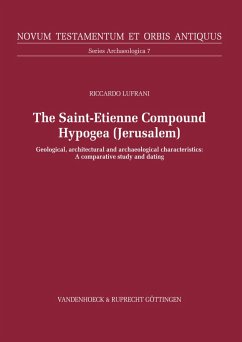In 1885, a large hypogeum was discovered at the Saint-E¿tienne Compound, the domain acquired only two and a half years before by the Dominicans on the western slope of El Heidhemiyeh hill, about 250 m north of the Jerusalem Ottoman wall.
After the unearthing of a second large hypogeum, only fifty metres north of Hypogeum 1, in their monumental work on the history of Jerusalem, the two eminent Dominican scholars Louis-Hugues Vincent and Felix-Marie Abel proposed to date the two burial complexes to the Hellenistic or Roman period.
This dating remained unchallenged until the survey of 1974-75, carried out by the distinguished Israeli archaeologists Gabriel Barkay and Amos Kloner, who proposed to date the two burial caves towards the end of the Judahite kingdom, on the basis of an unsystematic comparison of few architectural features with those of other tombs.
In the frame of the improved knowledge of the broad and adjacent archaeological contexts since the last study of the Saint-E¿tienne Compound Hypogea, between 2011 and 2014 Riccardo Lufrani carried out a detailed survey of the two burial caves, providing new and more detailed photographic, topographic, archaeological and geological documentation.
The systematic comparison of the significant architectural features of the Saint-E¿tienne Compound Hypogea with a consistent sample of 22 tombs in the region suggest dating the hewing of the two hypogea to the Early Hellenistic period, shedding a new light on the history of Jerusalem.
After the unearthing of a second large hypogeum, only fifty metres north of Hypogeum 1, in their monumental work on the history of Jerusalem, the two eminent Dominican scholars Louis-Hugues Vincent and Felix-Marie Abel proposed to date the two burial complexes to the Hellenistic or Roman period.
This dating remained unchallenged until the survey of 1974-75, carried out by the distinguished Israeli archaeologists Gabriel Barkay and Amos Kloner, who proposed to date the two burial caves towards the end of the Judahite kingdom, on the basis of an unsystematic comparison of few architectural features with those of other tombs.
In the frame of the improved knowledge of the broad and adjacent archaeological contexts since the last study of the Saint-E¿tienne Compound Hypogea, between 2011 and 2014 Riccardo Lufrani carried out a detailed survey of the two burial caves, providing new and more detailed photographic, topographic, archaeological and geological documentation.
The systematic comparison of the significant architectural features of the Saint-E¿tienne Compound Hypogea with a consistent sample of 22 tombs in the region suggest dating the hewing of the two hypogea to the Early Hellenistic period, shedding a new light on the history of Jerusalem.
Dieser Download kann aus rechtlichen Gründen nur mit Rechnungsadresse in A, B, BG, CY, CZ, D, DK, EW, E, FIN, F, GR, H, IRL, I, LT, L, LR, M, NL, PL, P, R, S, SLO, SK ausgeliefert werden.









